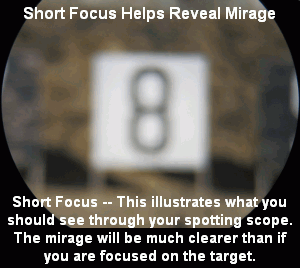April 7, 2022. We are repeating an excellent article by Steven Blair about wind reading, at the request of Shooters’s Forum members. Steven Blair, a top F Class shooter, discusses mirage, topography effects and tail winds as well as other subtle factors that can frustrate shooters. Steve explains that wind effects are complex. There’s more to them than velocity and angle. Wind reading tips for competitive shooters
Steven Blair, Past California State Long Range F–Open Champion
Before you start a match, take some time to inspect the range for obstructions, range topography (berms or backstop), trees, buildings, and other structures that could affect wind flow. Imagine what would happen if the wind came from the right or left, headwind or tailwind. Depending on the direction of the wind, there may be significant effects on range. A head or tailwind may cause elevation changes in the berms by causing them to ripple across the berms. A tall side berm like the Ben Avery east side berm can cause turbulence if the wind blows from that direction. While blocking features can shield most of the wind, a break at the range can funnel strong gusts through it without any other indications. Keep track of the different wind directions and make notes to refer back to them if the wind direction changes. Tony Robertson, tip. Use a Scope Even when Shooting a Scoped Rifle
A good spotting scope is able to “see” mirage better than a high-end rifle scope. Position your spotting scope on the line, just like sling shotters do. It will be easy to use and can be moved easily. The scope should be focused approximately 1/3 of the distance down range, or where wind effects are most likely to occur. While you wait for pit service, take a quick glance at the flags while you wait and compare them to your scope sight image. While I sometimes see ambiguous indications at a target through the rifle scope’s scope, I can see clear indications of wind direction and speed when looking through the spotting scope from a shorter distance. Last weekend, the wind was blowing from the east when I was shooting the Arizona Palma Championship at Ben Avery. The line was crowded with shooters from all directions, and they were losing points because they were shooting to the left. The mirage at the target looked mild and the flags didn’t indicate strong wind. The mirage suddenly seemed to be flowing twice as fast at 500 yards than it was closer. It wasn’t until the access road ran through the berm that I realized what was happening. (Tip courtesy Gary Eliseo. Don’t react too strongly to an anomaly
A headwind or tailwind can cause elevation problems on ranges with large berms. It is difficult to predict when this will happen. If conditions are causing elevation changes, and other competitors are also experiencing the same problem it is best to ignore it. Avoid shooting when the tail or head wind is gusting. This is just as important as avoiding shooting in crosswinds. If you react to elevation changes caused by range, it is likely to make the problem worse. No matter if the problem is caused from ammunition or range, keep your waterline held until you have proof that something fundamentally changed. My.284 Shehane usually requires a click or two during string as the barrel warms. This is normal and can be managed. If your shots are just bouncing around in the 10 band, you can leave it alone. A gust pushing a shot into a 9 ring is another possibility. If conditions are not changing and one shot goes out, it could be due to an unpredicted occurrence. Tip courtesy of “School of Hard Knocks”. Adjust Spotting Scope Focus and Magnification as Required to View Mirage vs. Target Detail
F-Class requires only the ability to see spotters, mirage, and scoring disks. This does not require a lot of magnification. My scope is a Nikon 25x75x82mm EED. It is a great scope for the price and allows you to see small variations in mirage. It is useful to have high magnification, which can be decreased if needed. Different situations call for different power settings.
In very good viewing conditions, I set my scope at 75X. My spotting scope is set at 40X for matches with heavy mirage. The mirage is subtler in the morning so I use a higher magnification. Mirage is easy to see even at this magnification. I practice at 300 yards and closer with my spotting scope set at maximum power (75X), so I can see the tiny 6mm holes in my 6BR rifle. To see bullet holes and mirage, I need to focus back-and-forth between shots. Steven Blair is the 2012 California State Long Range F-Open Champion. He has been shooting since childhood and has competed for over 30 years. Steve spent 16 years working in Engineering and IT at General Atomics before retiring. Steve spent 16 years in Engineering and IT with General Atomics before retiring.

















